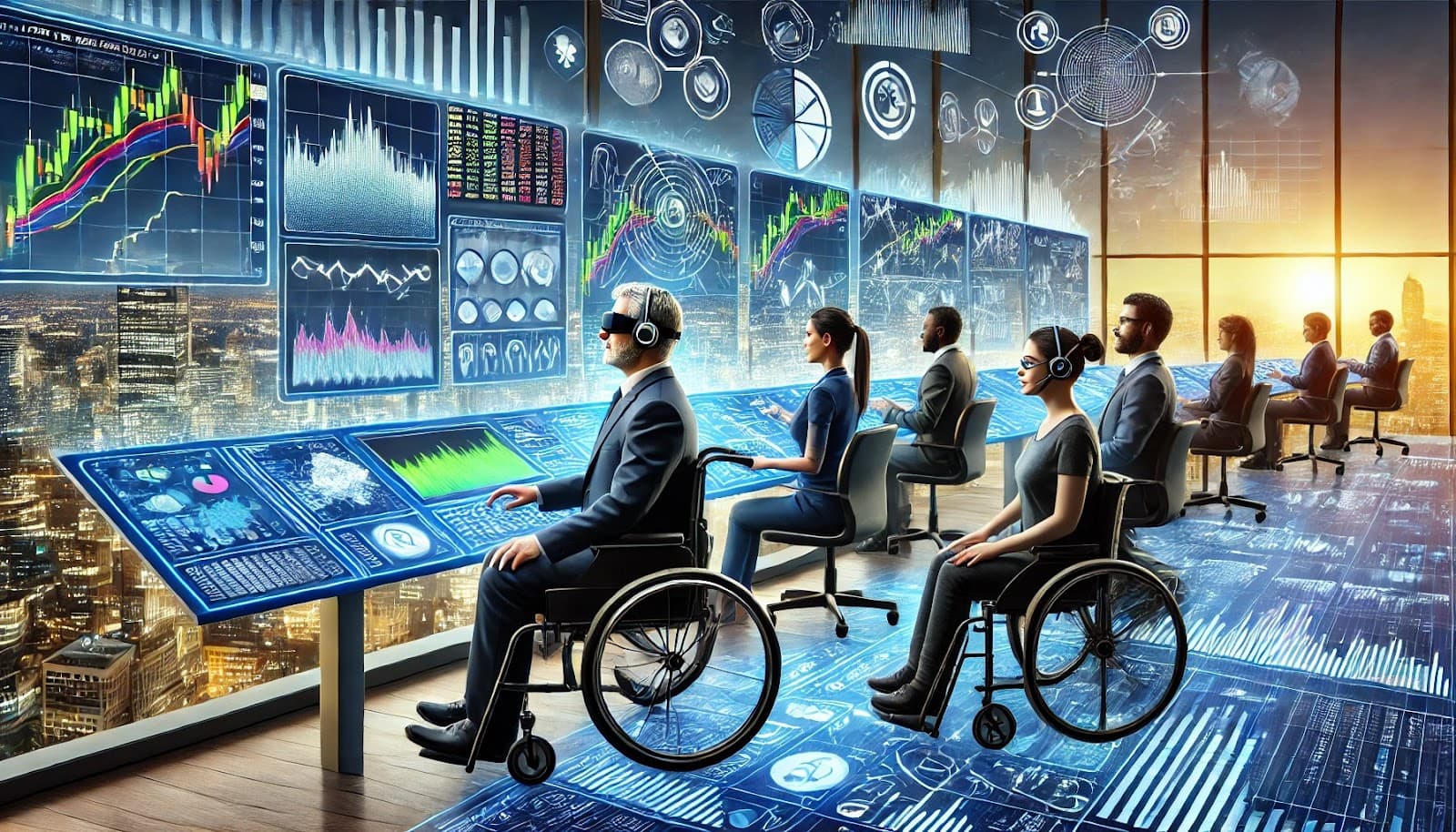How Trading Platforms Are Using Technology to Improve Accessibility for Disabled Traders
Trading platforms are increasingly recognizing the importance of accessibility for disabled traders, and technology plays a key role in making this possible. To address the challenges faced by traders with physical, sensory, or cognitive disabilities, platforms are incorporating a variety of technological solutions. These include customizable user interfaces with larger fonts, high contrast modes, and voice-activated commands to help visually impaired users navigate seamlessly. Additionally, screen reader integration allows blind or low-vision traders to access real-time data, while speech recognition software enables traders with motor impairments to control the platform using only their voice. One such example is Exness MetaTrader 5, which offers a variety of accessibility features, allowing disabled traders to personalize their experience and trade with greater ease.
Moreover, innovative solutions like augmented reality (AR) and virtual reality (VR) are being explored to enhance accessibility further. These technologies help visually impaired traders “see” data and charts through 3D models or haptic feedback, providing an interactive and immersive trading experience. Platforms are also adhering to international accessibility standards such as WCAG (Web Content Accessibility Guidelines) and ADA (Americans with Disabilities Act), ensuring that their services are universally usable. As accessibility technology continues to evolve, it empowers disabled traders to participate more fully in the financial markets, offering them greater independence and equal opportunities for wealth generation, as seen in platforms like MetaTrader 5.
Overview of Trading Platforms
Trading platforms are software applications that allow individuals and institutions to buy, sell, and manage financial assets such as stocks, forex, commodities, and cryptocurrencies. These platforms act as intermediaries between traders and the financial markets, providing the necessary tools and services to facilitate trading. They typically offer real-time market data, charting tools, order execution, and risk management features. Trading platforms come in various forms, ranging from desktop applications to web-based platforms and mobile apps, allowing traders to access the markets from almost any device.
Some of the most well-known trading platforms include MetaTrader 4 (MT4), MetaTrader 5 (MT5), and cTrader, which are popular among retail traders for their robust features and ease of use. These platforms cater to a wide range of asset classes and provide various order types, technical analysis tools, and automation features. For institutional traders, platforms like Bloomberg Terminal and Thomson Reuters Eikon offer more advanced features such as direct market access, research, and news feeds. Trading platforms also prioritize security to protect users’ funds and personal information, often employing encryption and multi-factor authentication.
Here’s a simplified overview of how trading platforms work:
- Market Access: When you register on a trading platform, you connect to the financial markets through brokers or financial institutions that provide access to various exchanges. The platform allows you to view live price feeds, financial news, and market trends. These platforms may cover several asset classes, from equities to forex to digital currencies, depending on their specialization.
- Execution of Trades: Once you decide to buy or sell an asset, the platform routes your trade request to the appropriate market or exchange. You can place different types of orders, such as market orders, limit orders, and stop-loss orders, depending on your strategy. The platform then matches your trade with other market participants, ensuring the execution of the order at the best available price.
- Order Book and Liquidity: Trading platforms typically provide an order book, a real-time list of buy and sell orders, allowing you to see the supply and demand for an asset. The platform helps ensure liquidity, meaning there are enough buyers and sellers to facilitate your trade without significant price changes.
- Real-Time Data and Analysis: Platforms provide access to real-time market data, including price movements, volume, and historical trends. Most platforms also offer a variety of technical analysis tools (e.g., moving averages, oscillators) and charting tools to help traders analyze market behavior and make informed decisions.
- Risk Management: Trading platforms incorporate features such as stop-loss orders, margin trading, and leverage to manage risk. A stop-loss is used to automatically sell an asset when it reaches a certain price, preventing further losses. Leverage allows traders to control larger positions with a smaller amount of capital, though it increases the risk of loss.
- Execution Speed: One of the most important aspects of a trading platform is the speed at which orders are executed. Efficient platforms ensure quick order execution, which is crucial for traders looking to capitalize on short-term market fluctuations.
- Security: Trading platforms incorporate security measures such as encryption, two-factor authentication (2FA), and secure communication channels to protect user data and financial transactions. This is especially important in ensuring the safety of user funds and personal information.
- User Interface and Experience: Trading platforms provide a user-friendly interface, allowing traders to easily navigate, monitor their portfolio, and execute trades. Advanced features like automated trading bots, social trading (copying other traders), and mobile apps further enhance the trading experience for users of all skill levels.
Benefits of Using Technology for Trading Platforms
Using technology in trading platforms provides numerous benefits that enhance the trading experience for both retail and institutional traders. One of the key advantages is increased accessibility, allowing traders to access markets from anywhere and at any time through web-based platforms or mobile apps. This convenience enables individuals to manage their investments, execute trades, and monitor market conditions on-the-go. With advanced charting tools, real-time market data, and order management systems, traders can make more informed decisions and respond quickly to market movements.
Another significant benefit is the automation of trading strategies. Many modern platforms offer algorithmic trading features, allowing traders to implement custom trading strategies that execute trades automatically based on predefined criteria. This can help eliminate emotional decision-making, reduce human error, and ensure timely execution of trades. Additionally, technology enhances risk management by providing tools such as stop-loss orders, margin calculations, and position sizing, helping traders manage their capital and protect against excessive losses. With the continuous evolution of artificial intelligence and machine learning, trading platforms are also becoming smarter, offering personalized insights and predictive analytics to improve trading outcomes. These technological innovations have made trading more efficient, accessible, and user-friendly, benefiting traders of all skill levels.

How Trading Platforms Using Technology for Disabled Traders
Trading platforms are increasingly utilizing technology to create a more inclusive environment for disabled traders, addressing the unique challenges they face. For traders with visual impairments, platforms are integrating screen readers, voice recognition tools, and high contrast modes to help them navigate the platform with ease. These features allow visually impaired users to listen to real-time market data, charts, and news updates, ensuring they can make informed trading decisions. Moreover, many platforms now offer customizable interfaces, allowing users to adjust font sizes, color schemes, and layouts to meet their specific needs. This focus on accessibility ensures that traders with physical or sensory impairments can participate fully in the financial markets without relying on external assistance.
For motor-impaired traders, many platforms have introduced voice-activated trading functions and gesture-based controls that allow users to execute trades and manage their portfolios without needing to use a mouse or keyboard. This technology makes trading more accessible for those who face difficulty with fine motor control. Furthermore, keyboard shortcuts and alternative input devices are being adopted to assist traders who struggle with traditional input methods. In platforms like Exness MetaTrader 5, advanced accessibility features are designed to accommodate traders with a range of disabilities, making it easier for them to access charts, execute trades, and manage their accounts. These technological innovations not only improve accessibility but also empower disabled traders, giving them greater independence and an equal opportunity to succeed in the financial markets.
Key Technologies Shaping Accessible Trading
| Technology | Description | Impact on Disabled Traders |
| Artificial Intelligence (AI) | AI adapts to individual traders’ needs, offering real-time assistance and personalized recommendations. | Helps traders with cognitive impairments by simplifying complex data. |
| Machine Learning (ML) | ML algorithms predict market trends based on individual trading habits, improving decision-making. | Provides intuitive decision-making and trade predictions for disabled traders. |
| Virtual Reality (VR) | VR offers immersive, 3D visualizations of market data, simulating the market through sensory inputs. | Enhances market interpretation for visually impaired traders with haptic feedback. |
| Augmented Reality (AR) | AR overlays market data in the real world, providing interactive visualizations and spatial audio. | Improves accessibility for traders with visual impairments through audio and visual cues. |
| Accessibility Standards (WCAG, ADA) | Platforms increasingly adhere to accessibility standards to ensure inclusivity. | Provides a more inclusive trading environment for all traders, regardless of ability. |
The Future of Accessible Trading
The future of accessible trading looks promising, with emerging technologies set to further revolutionize the way disabled traders interact with financial markets. One of the most exciting prospects is the continued integration of artificial intelligence (AI) and machine learning (ML) into trading platforms. These technologies can create more personalized experiences by adapting to the specific needs of disabled traders, offering real-time assistance, trade recommendations, and even predicting market trends based on individual trading habits. AI-driven tools could also help traders with cognitive impairments by simplifying complex data and presenting it in an easy-to-understand format, making decision-making more intuitive.
Role of Virtual and Augmented Reality (VR & AR)
In addition, virtual reality (VR) and augmented reality (AR) are expected to play a significant role in making trading more accessible, particularly for those with visual impairments. VR and AR technologies can provide immersive, 3D visualizations of market data, allowing visually impaired traders to “feel” or experience the market through haptic feedback or spatial audio. These innovations could give disabled traders more control over their trades, enhancing their ability to interpret market conditions in real time.
Increasing Adherence to Accessibility Standards
Furthermore, as platforms increasingly adhere to accessibility standards such as WCAG (Web Content Accessibility Guidelines) and ADA (Americans with Disabilities Act), it is likely that we will see even more widespread adoption of inclusive features. The continued evolution of technology promises to not only level the playing field for disabled traders but also push the boundaries of what is possible in terms of accessibility and inclusion in financial markets.
Conclusion
Trading platforms are increasingly leveraging advanced technology to create a more inclusive environment for disabled traders. Through innovations such as customizable interfaces, screen readers, voice-activated commands, and alternative input devices, platforms are making it easier for individuals with physical, sensory, and cognitive disabilities to engage in financial markets. These technological advancements not only enhance accessibility but also empower disabled traders by allowing them to trade independently and make informed decisions. As the industry continues to adopt emerging technologies like artificial intelligence, virtual reality, and augmented reality, the future of accessible trading looks promising, offering even greater opportunities for inclusion.



